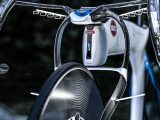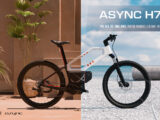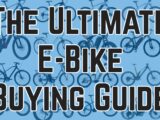
This is Why Mountain E-Bikes Are Better Than Normal MTBs
September 10, 2022E-bikes can take out the hard work of off-road riding, turning mountains into molehills and enhancing the pleasure of scenic, traffic-free cycling even if you’re not an athletic rider. We check out the pros and cons, investigate the legal aspects and talk about which really is best. Should you buy a mountain e-bike or a normal one…
Going Off-Road
‘Off-road’ can cover a huge range of different types of terrain and riding styles, from trundling gently along farm tracks to tackling technical downhills at speed, with non-competitive leisure riding in challenging terrain somewhere in the middle. While most bikes, electric or not, can tackle the easiest of off-roading, there’s really no substitute for a purpose built machine when the terrain gets more serious.
Proper mountain bikes have fat, knobbly tyres for traction and impact resistance. Handlebars are wide for plenty of leverage and control. ‘Hardtails’ have suspension forks but no suspension for the rear wheel, while ‘soft-tails’ or full suspension bikes provide suspension on both wheels. Adding (good) rear suspension does typically add noticeably to cost, weight and maintenance, so many off-roaders stick to the lighter hardtail designs, which are often also more responsive uphill (because rear suspension can often bounce as you pedal, soaking up some of your energy).
But full suspension comes into its own on the downhills – perhaps the most enjoyable aspect of mountain biking. As well as greater comfort it also offers, more importantly perhaps, greater control.
It’s the flip side, the uphill grind, where electric assist power can really make a huge difference. Instead of dragging yourself up in low gear, the motor power lets you keep up a decent speed and without huge athletic effort. It’s also great where you might otherwise ‘bog down’ – in heavy mud, gravel or snow.
Mountain e-bikes open up the countryside for a huge cohort of riders who for whatever reason find the fitness demands of unassisted MTB riding a barrier. With the most physically demanding aspects taken care of by the motor, the pleasures of being out in the wild, the joy of free movement and the social aspect of keeping up with fitter companions can all be enjoyed to the full.
And the downside? Well, it’s all about the weight. With a lightweight MTB, one of the pleasures is its easy manoeuvrability. Add motor and batteries, and the extra inertia of the bike makes it less easy to move around underneath you or to hop over obstacles.
How much of an issue this is depends on your riding style. Fast, skilled riders who are used to lighter bikes will, I’d venture to guess, find it more of a concern than leisure MTBers who will simply adapt their riding to keep within their bike handling comfort zone.
Off-roading can certainly add a new dimension to your cycling, taking you into some of the UK’s most beautiful scenery and with electric assist MTBs, it’s accessible to more people than ever before.
On the following pages you’ll find reviews of electric MTBs across the price spectrum, followed by a round-up of other models available, and some closing thoughts. I hope it’ll inspire you to take your riding off the beaten track!
The Law
The UK law for electric MTBs is clear: when used on the public highway they need to comply with the same limitations as other e-bikes if they are to be treated as bicycles not mopeds (250W rated motor, 15 mph cut-off, rider over 14 years old). This covers all public rights of way and places where the public have access: roads, bridleways, byways and footpaths where cycling is permitted. Other areas such as Forestry Commission land and canal towpaths often allow off-road cycling on waymarked routes by permission of the landowner, and typically these will work on the same definition of a ‘bicycle’ as for public highways.
There are a number of electric MTBs on the market with ‘off road modes’, available either instantly via a pushbutton or switch (now illegal on new UK bikes) or via some sort of set-up or configuration. This mode will provide extra power, extra speed or usually both. High power kits are also available, as are ‘mods’ to de-restrict otherwise compliant drive systems. As I understand it, such bikes can not be used legally in higher power mode except on private land (where there is no public access) with permission of the landowner, or unless they are registered as a moped and then used only where moped riding is legal.
Even when used on-road in ‘legal’ mode, the presence of any extra power or speed mode could prove a complication for insurance purposes in the event of an accident. There’s also considerable potential for a backlash against all off-road electric bikes if users of ‘boosted’ electric MTBs are inconsiderate, unfortunate enough to cause an accident, or even just too conspicuous. I can’t deny such machines can be great fun in an appropriate setting, but generally I’d advise against their use to keep on the right side of the law. All off-road cyclists, powered or not, should of course ride responsibly and carefully, respecting other countryside users and giving way to pedestrians and horse riders in particular.

So what have we learned from riding mountain e-bikes? Here are a few brief thoughts:
I may be biased by my own lack of skill and fitness, but I think electric MTBs will probably have limited appeal to the young and fit who love the jumps, stunts and general more radical aspects of mountain biking. Even now in 2022, they are still too expensive and too heavy.
They’ll appeal much more to those looking to mountain biking for access to traffic-free trails, scenery, nature and the fun of descending – but without wrecking the bike, the trail or the rider! I think crank drive does have the edge for more technical riding: in low gear, it gives you huge torque to pull yourself out of trouble. Good hub drives come close, but can’t quite match this.










